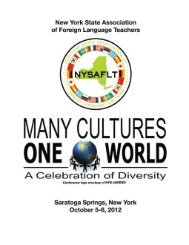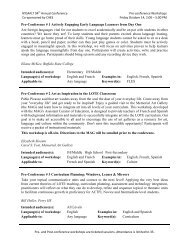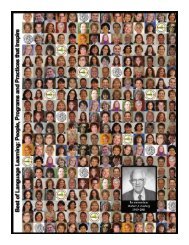THE COMPLETE CURRICULUM Ensuring a Place for the Arts and ...
THE COMPLETE CURRICULUM Ensuring a Place for the Arts and ...
THE COMPLETE CURRICULUM Ensuring a Place for the Arts and ...
- No tags were found...
Create successful ePaper yourself
Turn your PDF publications into a flip-book with our unique Google optimized e-Paper software.
NASBE<strong>THE</strong> <strong>COMPLETE</strong> <strong>CURRICULUM</strong>Glastonbury, Connecticut’sLanguage ProgramThe language program inGlastonbury Public Schools began in1957, <strong>and</strong> is one of <strong>the</strong> longest runningarticulated programs of any publicschool system in <strong>the</strong> country <strong>for</strong>students in grades 1-12. The schooldistrict, set in a middle-class suburb ofHart<strong>for</strong>d, Connecticut, m<strong>and</strong>ateslanguage study <strong>for</strong> all students ingrades 1-8. Spanish is taught to allstudents in grades 1-5. The firsttransition year, <strong>for</strong> students in grade 6,allows <strong>for</strong> a student to continue withSpanish or begin French. Seventh <strong>and</strong>eighth grade students have ano<strong>the</strong>roption—to begin <strong>the</strong> study of Russian.Finally, high school students have <strong>the</strong>option of studying Spanish, French,Russian, Latin, or Japanese. In recentyears, Japanese has been offered tosome students in <strong>the</strong> elementarygrades. The instruction time rangesfrom 20 minutes twice a week <strong>for</strong>students in grade 1, to 45 minutes perday <strong>for</strong> students in grades 7-12.The program has four goals:• To teach students to communicatebeyond <strong>the</strong>ir native languagesin order to participateeffectively in <strong>the</strong> world;• To enable students to recognizewhat is common to all humanexperience <strong>and</strong> to accept thatwhich is different;• To enhance students’ ability toanalyze, compare <strong>and</strong> contrast,syn<strong>the</strong>size, improvise, <strong>and</strong>examine cultures through alanguage <strong>and</strong> a perspective o<strong>the</strong>rthan <strong>the</strong>ir language; <strong>and</strong>• To have students begin languagestudy as early as possible in aninterdisciplinary environment.More in<strong>for</strong>mation can be foundonline www.<strong>for</strong>eignlanguage.org. 27<strong>the</strong> country. Thus it is important <strong>for</strong>states to not only have in place a set ofcomprehensive st<strong>and</strong>ards <strong>for</strong>students <strong>and</strong> teachers, but to ensurethat those st<strong>and</strong>ards are beingimplemented in K-12 classrooms, aswell as teacher education programsthroughout <strong>the</strong> country.In a recent poll commissioned byAmericans <strong>for</strong> <strong>the</strong> <strong>Arts</strong>, more than 90percent of respondents agreed that<strong>the</strong> arts are vital to providing a wellroundededucation <strong>for</strong> our children.In order <strong>for</strong> teachers <strong>and</strong> administratorsto implement state st<strong>and</strong>ards<strong>for</strong> students at <strong>the</strong> classroom level, <strong>the</strong>Study Group recommends severalstrategies that should be employed toensure success.Recommendation 6: Incorporatearts <strong>and</strong> <strong>for</strong>eign language learningin <strong>the</strong> early years into st<strong>and</strong>ards,curriculum frameworks, <strong>and</strong> courserequirements. Also, encourage localschool districts to incorporate <strong>the</strong>arts <strong>and</strong> <strong>for</strong>eign languages intoinstruction in <strong>the</strong> early years,whenever possible.Introducing both <strong>the</strong> arts <strong>and</strong><strong>for</strong>eign languages to children at an earlyage is key to students’ success in <strong>the</strong>sesubjects. As studies have shown, <strong>the</strong>earlier instruction begins, <strong>the</strong> better.There are sound practical <strong>and</strong> pedagogicalreasons <strong>for</strong> beginning languagestudy in <strong>the</strong> early years. To build apopulation fluent in Chinese, Arabic,Pashtu, or o<strong>the</strong>r languages important<strong>for</strong> national security it is critical thatstudents begin some language studyearly <strong>and</strong> follow a well-articulatedlanguage program through highschool. This provides <strong>the</strong> necessaryfoundation to develop fluency in <strong>the</strong>less commonly taught languages.In a recent article on brainresearch, it was noted that “someabilities are acquired more easilyduring certain sensitive periods, or‘windows of opportunity’.… [A]nadult certainly can learn a secondlanguage <strong>and</strong> learn to speak it quitewell. However, it is much moredifficult to learn a <strong>for</strong>eign languageafter age 10 or so, <strong>and</strong> <strong>the</strong> languagewill probably be spoken with anaccent.” 25 Younger students learn asecond language by acquiringautomatic patterns <strong>and</strong> vocabulary,<strong>and</strong> <strong>the</strong>y can more easily <strong>and</strong> naturallythink in <strong>the</strong> target language; olderstudents rely more on mentallytranslating from <strong>the</strong>ir native language,which slows down <strong>the</strong> processing of<strong>the</strong> target language.Still, one of <strong>the</strong> key attributes of asuccessful language program is that itsgraduates are able to use <strong>the</strong>irlanguage knowledge in later life.Research shows it is important tooffer <strong>for</strong>eign language instruction aspart of <strong>the</strong> academic curriculum in <strong>the</strong>early grades, with continuationthrough middle <strong>and</strong> high school inorder to reach this goal.Research has also shown <strong>the</strong>benefits of music <strong>for</strong> brain development.26 For example, brain scans revealthat almost all of <strong>the</strong> cerebral cortex isactive while a musician per<strong>for</strong>ms.Studies have also revealed <strong>the</strong> positiveimpact music has on improvingreading scores, as well as on subjectsthat require spatial-temporal reasoning,such as ma<strong>the</strong>matics <strong>and</strong> science.Early childhood education is justbeginning to earn <strong>the</strong> recognition itdeserves as a critical key to studentachievement in later years. Recently,federal, state, <strong>and</strong> local policy <strong>and</strong>practice has begun to recognize <strong>the</strong>20






